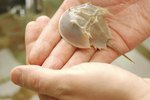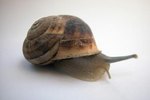
Mollusks are a massive, diverse phylum of invertebrates found throughout the world from the ocean floor to mountainous elevations. Gastropoda is the largest class of mollusks, and includes around 35,000 species of snails, slugs, limpets, conches, nudibranchs and abalones. Members of gastropoda, called gastropods, feature unique internal and external morphology designed to protect their soft bodies and keep them firmly attached to the ground.
Head
A gastropod’s head includes sensory organs such as tentacles, eyes, mouth and radula -- a tongue-like mass. Terrestrial snails generally have four tactile tentacles, while water snails typically have two fixed tentacles. Depending on the individual species, a gastropod’s eyes may be located either on the tip of the tentacles or at the tentacle’s base, much like the freshwater pond snail (Lymnaea stagnalis).
Visceral Mass
A gastropod’s visceral mass is its collection of internal organs, including the heart, kidney, reproductive organs and digestive system. A gastropod’s digestive tract is twisted back onto itself as a result of a process called “torsion.” Torsion results in an asymmetrical body mass where the anus actually lies over a gastropod’s head and mouth.
Foot
The name gastropod is derived from the Greek stem “gastr” meaning stomach and “pod” meaning foot. The name perfectly describes a gastropod’s method of locomotion: they use a muscular, flattened foot on the stomach side of their body to crawl, swim, attach and burrow.
Mantle
The mantle is the upper portion of a gastropod’s body. In shelled gastropods, it's the part of the body that always remains inside the shell. Internally, the mantle contains the visceral mass; externally it produces and secretes calcium carbonate and lime, which hardens into a protective shell in many gastropod species.
Shell
Not all gastropods have shells. Land slugs traverse the world without a protective barrier. If a gastropod has a shell, it is generally symmetrical yet always coiled due to the torsion of the mantle and internal organs. Shell shape varies by species. Conches, for example, have distinct elongated, spindle-shaped shells while limpets have flatter, conical shells twisting as they flare out. A gastropod’s shell serves to protect its delicate visceral mass.
References
Photo Credits
-
Comstock/Comstock/Getty Images
Writer Bio
Christina Stephens is a writer from Portland, Ore. whose main areas of focus are pets and animals, travel and literature. A veterinary assistant, she taught English in South Korea and holds a BA in English with cum laude honors from Portland State University.



